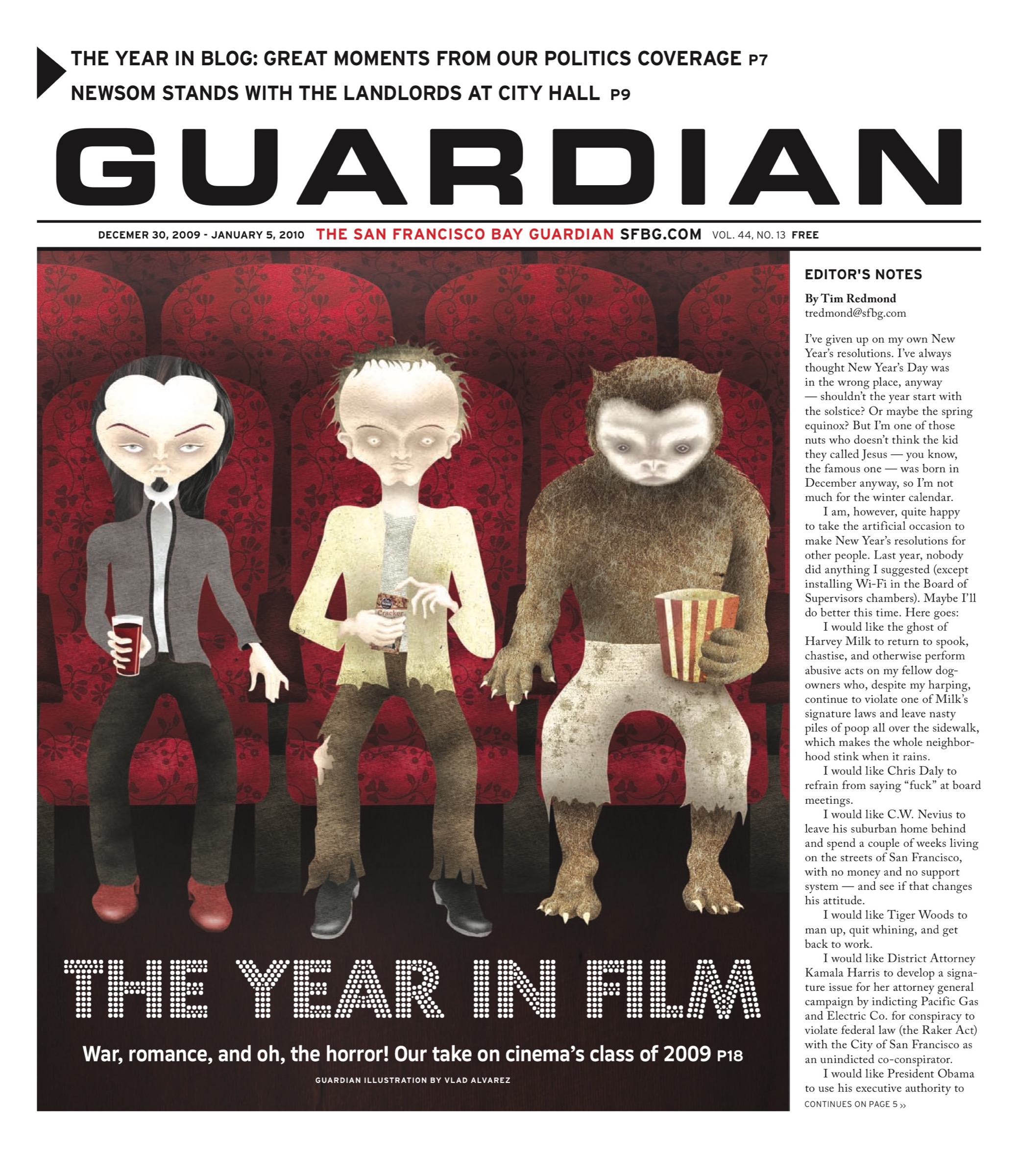SUPER EGO Wherein we present an alphabetical rundown of New Year’s Eve nightlife diversions, sprees, galas, fetes, and carousals.
AFROLICIOUS Around the world! Ultimate Latin funk brothers Senor Oz and Pleasuremaker team up with DJ Jimmy Love of Non-Stop Bhangra and Trinidadian MC Fresh4Life for a global-groove blast.
9:30 p.m., $15–$25. Elbo Room, 647 Valencia, SF. www.elbo.com
BE It’s another glorious case of trance mania — perfect for our ADD times — at 1015 Folsom. Above and Beyond, Super8 and Tab, and DJ Taj keep the eve pumping wildly.
10 p.m.–8a.m., $50–$100. 1015 Folsom, SF. www.1015.com
BEARRACUDA Will large, hairy gay men still be in next year? Probably. DJ Ted Eiel of MegaWOOF sheds all over the tables at this rump-pumping free-for-all.
8 p.m.–4 a.m., $32 advance. Deco, 510 Larkin, SF. www.bearracuda.com
BEYOND BEYOND Find a queer hottie to kiss in the new as the wonderfully alt Stay Gold kids, DJs Rapid Fire and Pink Lightning, host Dr. Sleep, Bunny Style, and tons of shawties.
9 p.m., $15. Makeout Room, 3225 22nd St., SF. www.makeoutroom.com
BLOW YOUR WHISTLE Miss Juanita More! gathers a gaggle of queer underground superstars to pop your cork, including DJ Pee Play, Stanley Chilidog, Joshua J, Tiara Sensation, and Miss Honey.
9 p.m., $35. Bambuddha Lounge, 601 Eddy, SF. www.juanitamore.com
BOOTIE BOOTLEG BALL Mashup the decades at the city’s — possible world’s — biggest mashup club, with Adrian and Mysterious D, Smash Up Derby, and Freddy King of Pants.
8 p.m.–late, $40 advance only. DNA Lounge, 375 11th St., SF. www.dnalounge.com
CLUB 1994 Don’t let the name fool you — there’ll be classic jams pumped for sure, but with special electro guests Wallpaper the vibe will be pure 2010.
9 p.m.-3 a.m., $18.50 advance. Paradise Lounge, 1501 Folsom, SF. www.club1994.com
CLUB COCOMO NYE What would New Year’s be without a little salsa? Break out your cha cha heels and join live band Avance and KPFA DJ Luis Medina on the floor.
8 p.m., prices vary. 650 Indiana, SF. www.clubcocomo.com
CODA NYE Jazz it up for the next chapter of the millennium at the deluxe supper club, with the Mike Olmos Organ Combo, Dynamic, and Hot Bag.
6 p.m., prices vary. Coda, 1710 Mission, SF. www.codalive.com
COMEDY COUNTDOWN Ha ha ha — the naughts. It was to laugh! And still will be, with chuckleheads Greg Behrendt, Maria Bamford, Amy Schumer, Doug Benson, and loads more.
8:30 p.m., $49.50. Palace of Fine Arts, 3301 Lyon, SF. www.livenation.com
DEBASER + BOOTY BASEMENT Party down ’90s style, when Debaser’s grunge meltdown meets Booty Basement’s hip-hop gangsta swagger. DJs Jamie Jams, Dimitri Dickenson, Emdee, and Ryan Poulsen bring it.
9 p.m.-4 a.m., $15. The Knockout, SF. 3223 Mission, www.knockoutsf.com
DECADANCE Acoustic rock meets electro-hop in the universe of headliner (and apparent hair model) Chris Clouse. Longtime dance favorites DJ Zhaldee and Chris Fox warm it all up.
9 p.m.–3 a.m., $99 advance. Mezzanine 444 Jessie, SF. www.mezzaninesf.com
THE GLAMOROUS LIFE Omnivorously poppy-hoppy DJ White Mike pops the cork at the newly renovated (and quite lovely) Beauty Bar.
10 p.m., $10. Beauty Bar, 2299 Mission, SF. www.beautybar.com
MARGA GOMEZ NYE SPECTACULAR More hilariously hilarious queers (and friends) than you can count at the off-her-awesome-rocker comedian’s, yes, spectacular. With David Hawkins, Ben Lehrman, and Natasha Muse. Balloon drop!
7 p.m. and 9 p.m., $25/$30. Victoria Theatre, 2961 16th St., SF. www.therhino.org
OM 2010 Work it on out with the OM Records stable and some surprising talent, including techno Jesus Nikola Baytala, Lance DeSardi, Galen, M3, and Sammy D
9 p.m.-4 a.m., $20 advance. Triple Crown, 1760 Market, SF. www.triplecrownsf.com
OPEL NYE Bass-shaking goodness at the ever-bumping Opel’s year-end teardown, with Stanton Warriors, Syd Gris, Dex Stakker, and Melyss.
10 p.m.–4 a.m., $20–$50. Mighty, 119 Utah, SF. www.mighty119.com
PLANET ROCK Oh, Afrika Bambaata, “Amen Ra of Universal Hip-Hop Culture” — how could we not pop and lock it with you, and three floors of others, for 2k10?
8 p.m.–4 a.m., $25 advance. Club Six, 60 Sixth St., SF. www.clubsix1.com
REDLINE Dubstep took over in 2009 — celebrate the dominance with the Bay’s best steppers, like Sam Supa, Ultraviolet, Kozee, and Spacer.
8 p.m., $10. Matador, 10 Sixth St., SF. www.myspace.com/redlinedjs
SEA OF DREAMS The cavernous, Burnerish NYE joint celebrates 10 years with a stellar lineup — Glitch Mob, Ozomatli, Bassnectar, Ghostland Observatory, Sila and the Afrofunk Experience …
9 p.m.–5a.m., $75–$125. Concourse Center, 635 Eighth St., SF.
SOM NYE The turntablistic wonderfingers of Triple Threat meet the hiphop party cunning of Distortion 2 Static, with DJs Vinroc, Shortkut, and Prince Aries at this new hotspot.
9 p.m.- a.m., $25/$30. SOM, 2925 16th St., SF. www.som-bar.com
TEMPLE OF LIGHT Templekeepers Paul Hemming, Ben Tom, A2D, Jaswho?, Nacho Vega, and so many more ring in the new Zen.
9 p.m.–late, $40–$60. Temple, 540 Howard, SF. www.templesf.com
TRIGGER NYE The exquisite steroid pop of DJ Mykill is sugar rush enough to get you through a night of Trigger and the Castro as the balls drop
9 p.m., $15 advance. Trigger, 2344 Market, SF. www.clubtrigger.com
THE TUBESTEAK CONNECTION
DJ Bus Station John helps all the nice-naughty queers cruise into a dirty new decade of bathhouse disco indulgence.
9 p.m., $10. Aunt Charlie’s Lounge, 133 Turk, SF. www.auntcharlieslounge.com
QOOL NYE
The longest running happy hour dance party in SF joins with Honey Soundsystem and takes on the night, with DJs Silencefiction, Peeplay, Jondi & Spesh, Ken Vulsion, Derek Bobus, and Looq Records playmates.
9 p.m., $15–$50. 111 Minna Gallery, 111 Minna, SF. www.qoolsf.com

